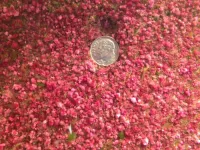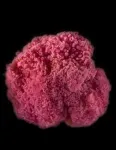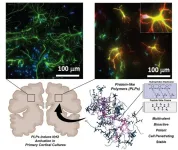(Press-News.org) By Wynne Parry
WOODS HOLE, Mass. – Like humans struggling to get through the COVID-19 pandemic, bacterial cells need social distancing to thwart viruses. But in some situations, such as inside elevators or within the candy-colored bacterial structures known as “pink berries,” staying apart just isn’t feasible.
Looking like spilled Nerds or Pop Rocks, the communal, multicellular pink berries litter the submerged surface of salt marshes in and around Woods Hole. New research conducted at the Marine Biological Laboratory (MBL) uncovers evidence that a genetic mechanism may help the berry-building bacteria — and others like them — protect against disease. The study, published this week in Proceedings of the National Academy of Sciences, also has implications for understanding the evolution of single-celled organisms, like bacteria, into complex multicellular ones, including humans.
“It tells us about the challenges we faced back when we were little balls of cells,” says Lizzy Wilbanks, an MBL Whitman Fellow and a microbiologist at the University of California, Santa Barbara. “If you're forming multicellular structures, you've got to evolve some pretty fancy immune defenses in order to stay alive.”
Mysterious, mutation-generating systems
Wilbanks first encountered the pink berries as a graduate student enrolled in MBL’s Microbial Diversity course. These spherical aggregates are among the structures bacteria form when genetically similar individuals stick close together and coordinate their activity. The pink berries are populated by a species of bacteria called Thiohalocapsa PSB1, which feeds itself using sulfur and light, plus a relatively small number of other symbiotic bacteria. By working together, these cells create pockets free of oxygen, which could poison them, and acquire the weight necessary to settle safely into their ideal habitat.
Like all organisms, these cooperative microbes risk contracting viruses from their environment. Pink berries and other multicellular bacteria have a heightened need for protection, since — like us — they are composed of genetically similar cells packed tightly together, with no social distancing possible.
“It’s a perfect cocktail for an epidemic to blow through and wipe out everything,” Wilbanks says.
Through her collaborator Blair Paul, assistant scientist at MBL, Wilbanks learned about an unusual genetic mechanism that they found to be abundant within Thiohalocapsa. Known as diversity-generating retroelements (DGRs), this system contains sections of DNA that are transcribed into RNA and back into DNA through an error-prone process, then inserted into a target gene for mutation.
In this way, DGRs introduce lots of new genetic variation, the raw material for adaptation, into specific spots within the genomes. Scientists have found these systems in viruses, bacteria, and other microbes called archaea, yet they don’t fully understand how the microbes use them.
Wilbanks and Hugo Doré, then a postdoctoral scientist in her lab and the study’s first author, began discussing what DGRs might accomplish for Thiohalocapsa. Through their research, they learned the DGRs’ target genes include components related to those found in the immune systems of multicellular organisms, including humans, plants and even some fungi. The similarity to pieces of other organisms’ immune systems prompted the researchers to suspect the DGRs might diversify the sensor proteins Thiohalocapsa uses to defend against pathogens, analogous to the antibodies in our own immune systems.
All living organisms need to detect threats they have never encountered before. Humans and other vertebrates solve this problem by shuffling and mutating genes for their sensor proteins (antibodies) to generate a diverse army of sentinels. Though recent research has shown many components of our innate immune systems evolved from bacterial ancestors, scientists have never before seen in bacteria anything like our hyper-diverse antibodies.
A widespread immunological connection
The team first looked broadly at DGRs found in bacteria and archaea, focusing on the gene responsible for turning RNA back into DNA. This method divides the DGRs from bacteria and archaea into two groups. Within the group to which Thiohalocapsa belongs, they found that 82 percent of DGRs belong to microbes that form many-celled, cooperative structures, akin to the pink berries. Even though they belonged to distantly related microbes, the DGRs’ alterations tend to affect the same kind of immune system genes as they do in Thiohalocapsa.
Examining hundreds of individual pink berries, they found that DGRs had been actively diversifying 14 of the 15 total target genes in Thiohalocapsa. The amount of the variation found for these genes changed, however, depending on the site from which the pink berries had been collected. The viruses in pools in the same marsh may vary — perhaps driving the differences the team saw.
“The next frontier is showing what Thiohalocapsa is actually doing with its DGRs in the environment,” Wilbanks says.
In addition to offering a peek at the evolution of life, this research has practical implications. Wastewater treatment plants use multicellular bacteria to remove nutrients that can harm local ecosystems, and federal and industrial researchers are exploring a host of other applications for engineered clumps of microbes. These microbial structures face the same challenge — viral epidemics — as the pink berries. When engineering these microbial systems, Wilbanks says, it makes sense to mimic the DGR-based immunity of wild communal bacteria.
—###—
The Marine Biological Laboratory (MBL) is dedicated to scientific discovery – exploring fundamental biology, understanding marine biodiversity and the environment, and informing the human condition through research and education. Founded in Woods Hole, Massachusetts in 1888, the MBL is a private, nonprofit institution and an affiliate of the University of Chicago.
END
Hospital-acquired acute kidney injury (HA-AKI) is a common complication in hospitalized patients that can lead to chronic kidney disease and is associated with longer hospital stays, higher health care costs and increased mortality. Given these negative consequences, preventing HA-AKI can improve hospitalized patient outcomes. However, anticipating HA-AKI onset is difficult due to a large number of contributing factors involved.
Researchers from Mass General Brigham Digital tested a commercial machine learning tool, the Epic Risk of HA-AKI predictive model, and found it was moderately successful at predicting risk of HA-AKI in recorded patient data. ...
(Toronto, February 16, 2024) JMIR Publications is pleased to announce that JMIR Bioinformatics and Biotechnology has passed the Scientific Quality Review by the US National Library of Medicine (NLM) for PubMed Central (PMC). This decision reflects the scientific and editorial quality of the journal. All articles published from 2022 onward will be found on PMC and PubMed after their technical evaluation.
Launched in 2020, JMIR Bioinformatics and Biotechnology is a sister journal of Journal of Medical Internet Research ...
Standard chemotherapy regimens, which are mostly based on testing in relatively young and healthy patients, may do more harm to older adults with cancer who often struggle with other health issues. New research, published yesterday in JAMA Network Open, shows that lowering the dose and adjusting the schedule of how chemotherapy is given to older adults with advanced cancer can make life better for patients, without compromising their treatment goals.
The study, which was led by researchers from the University of Rochester Medical Center’s Wilmot Cancer Institute, focuses on how well older people tolerate chemotherapy. More than 30 percent of patients benefitted from treatment regimen ...
HOUSTON – (Feb. 16, 2024) – Rice University computer science researchers have found bias in widely used machine learning tools used for immunotherapy research.
Ph.D. students Anja Conev, Romanos Fasoulis and Sarah Hall-Swan, working with computer science faculty members Rodrigo Ferreira and Lydia Kavraki, reviewed publicly available peptide-HLA (pHLA) binding prediction data and found it to be skewed toward higher-income communities. Their paper examines the way that biased data input affects the algorithmic recommendations being ...
A study co-led by Professor Kelly Metcalfe of the Lawrence Bloomberg Faculty of Nursing, and researchers at the Familial Breast Cancer Research Unit at Women’s College Hospital, finds risk-reducing mastectomies (RRM) in women with a BRCA1 or BRCA2 genetic variant, significantly reduces the risk of being diagnosed with breast cancer and lowers the probability of death.
The study, published in the British Journal of Cancer, examined how RRM affects the rate of death of women with a pathogenic variant but no cancer diagnosis. To date, there has been only one other study published by researchers in the Netherlands that examines the impact ...
The Hope Foundation for Cancer Research, the public charity supporting SWOG Cancer Research Network, has recently established the Frank and Linda Meyskens Annual Endowed Lectureship on Advances in Cancer Prevention. Since the early 1980’s, Dr. Meyskens has been a leader in the recognition, development, and clinical usage of Prevention in the management of cancer. Frank and Linda have directed the development of this lectureship to advance the explosion of knowledge that is expanding opportunities to engage Prevention in personalized medicine, including early detection and genetically ...
A female White-eared opossum (Didelphis albiventris) found dead in 2021 in Bosque dos Jequitibás Park in the center of Campinas, one of the largest cities in São Paulo state, Brazil, died from rabies meningoencephalitis, according to a group of researchers at the University of São Paulo (USP) and Adolfo Lutz Institute (IAL), the regional reference laboratory, working with health professionals affiliated with public institutions in São Paulo city and Campinas.
Reported in an article published in the journal Emerging Infectious Diseases, the finding serves as an alert to the presence of the virus, which is deadly to humans, ...
Researchers led by Northwestern University and the University of Wisconsin-Madison have introduced a pioneering approach aimed at combating neurodegenerative diseases such as Alzheimer's disease, Parkinson's disease and Amyotrophic lateral sclerosis (ALS).
In a new study, researchers discovered a new way to enhance the body’s antioxidant response, which is crucial for cellular protection against the oxidative stress implicated in many neurodegenerative diseases.
The study published today (Feb. 16) in the journal Advanced Materials.
Nathan Gianneschi, the Jacob & Rosaline Cohn Professor of Chemistry at Northwestern’s Weinberg ...
(Santa Barbara, Calif.) — Anoxic marine basins may be among the most viable places to conduct large-scale carbon sequestration in the deep ocean, while minimizing negative impacts to marine life. So say UC Santa Barbara researchers in a paper published in the journal AGU Advances. As we explore ways to actively draw down the levels of carbon in the atmosphere, sending plant biomass to these barren, oxygen-free zones on the seafloor becomes an option worth considering.
“The big picture here is that all the best models that we have say that we have to do some form of net negative CO2 removal in order to hit climate goals,” said geochemist, geobiologist ...
Today’s Food and Drug Administration approval of a supplemental biologics license for the monoclonal antibody omalizumab (Xolair) highlights the vital role of the National Institutes of Health-supported research that underpins the FDA decision.
FDA has approved omalizumab for the reduction of allergic reactions, including anaphylaxis, that may occur with an accidental exposure to one or more foods in adults and children aged 1 year and older with food allergy. People taking omalizumab still need to avoid exposure to foods to which they are allergic. Omalizumab previously received FDA approval ...





